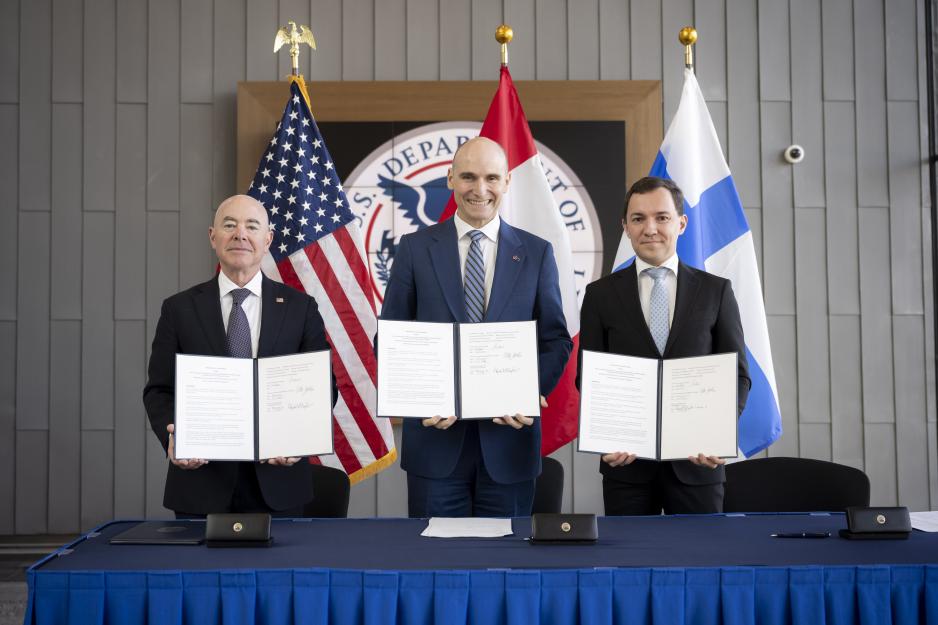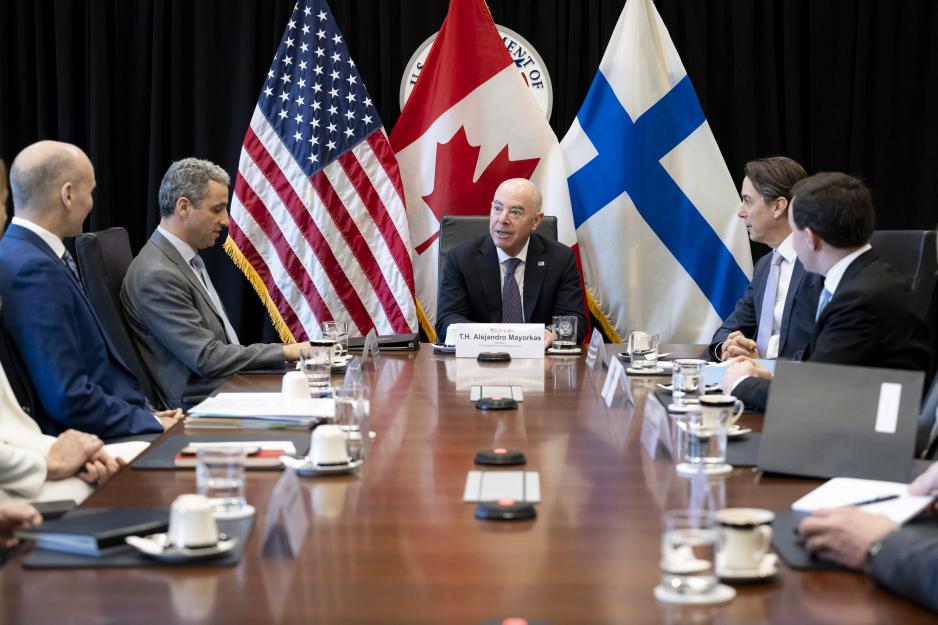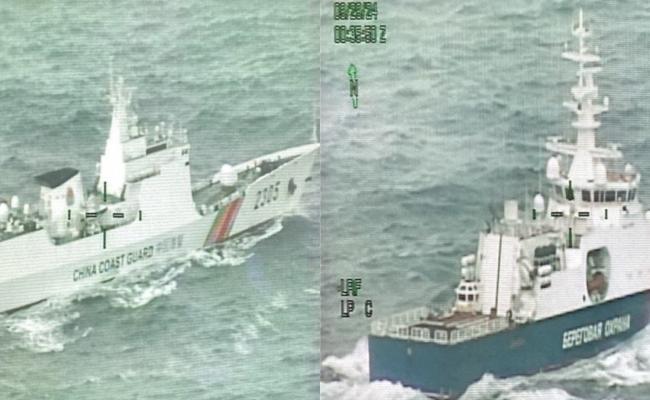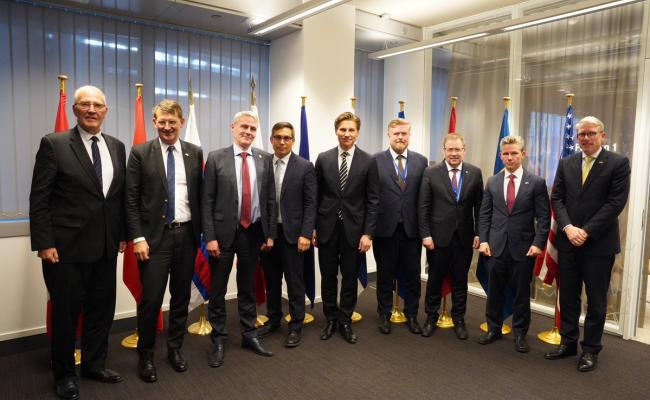US, Canada, and Finland Formalize Cooperation on Polar Icebreakers

The US Coast Guard icebreaker USCGC Healy and the Canadian Coast Guard icebreaker CCGS Sir Wilfrid Laurier during a joint operation in the Beaufort Sea last year. (Photo: Michael Underwood/US Coast Guard)
The US, Canada, and Finland recently signed a memorandum of understanding to begin working together on the design and construction of polar icebreakers. “This is a testament to the strength of allied cooperation in addressing strategic challenges,” say the parties.
Last week, the United States, Canada, and Finland signed a memorandum of understanding (MOU) on joint efforts to build icebreakers for operations in the Arctic and Antarctic.
The agreement formalizes the Icebreaker Collaboration Effort, or ICE Pact, which was launched by President Joe Biden, Prime Minister Justin Trudeau, and President Alexander Stubb on the margins of the NATO summit in Washington, D.C., in July.
The partnership deals with the design, production, and maintenance of polar icebreakers through the exchange of knowledge, information, and other resources.
“In signing the ICE Pact MOU, we have embarked on a transformative partnership that strengthens our ability to uphold international rules and maintain security in the Arctic and Antarctic regions,” the three countries say in a joint communique and continue:
“By jointly developing and producing world-class Arctic and polar icebreakers, we are laying the foundation for a resilient and competitive shipbuilding industry, capable of meeting both national and global demand for these critical assets.”
“This arrangement underscores our collective commitment to peace, stability, and prosperity in the polar regions and is a testament to the strength of allied cooperation in addressing strategic challenges.”
The partnership's components:
- Enhanced information exchange between the United States, Canada, and Finland
- Workforce development collaboration
- engagement with allies and partners
- research and development

From left: US Secretary of Homeland Security Alejandro Mayorkas, Canadian Minister of Public Services and Procurement Jean-Yves Duclos, and Finnish Minister of Economic Affairs Wille Rydman signed the ICE Pact MOU at the U.S. Coast Guard Headquarters in Washington, D.C. (Photo: Tia Dufour/US DHS)
Potential
“Each of our nations recognizes the need to enhance our Arctic and polar icebreaking capabilities to assert our collective presence in the Arctic and Antarctic regions. Building these specialized vessels at a faster pace, on a larger scale, and at competitive costs is a shared priority,” the communiqué also states.
The US, Canada, and Finland point out that the partnership has the potential to create a number of high-quality jobs and economic growth, support maritime infrastructure supply chains critical to national security, and empower scientific research.
Not least, the trio maintains that the ICE Pact can serve as the groundwork for like-minded nations to increase their polar capabilities in the Arctic and Antarctic regions.
“We invite allies and partners globally to purchase Arctic and polar icebreakers from Canadian, Finnish, and US shipyards, and benefit from reduced costs and faster delivery schedules that ICE Pact will enable,” say the parties in a joint statement.
Challenges China
With this, the US in particular is taking steps to challenge China's current dominance within the shipbuilding industry, according to Rebecca Pincus, Director of the Polar Institute at the Wilson Center.

Rebecca Pincus, Senior Fellow at the Foreign Policy Research Institute. (Photo: Wilson Center)
“The piece on encouraging allies and partners to purchace icebreakers produced through this collaboration is yet another example of the US government’s willingness to get creative in competing with China. China builds ships faster than anyone else in the world. The Chinese government has given significant subsidies to its shipyards to enable them to produce ships very quickly and cheaply,” comments Pincus on the Winson Center’s website.
“This MOU is confined to icebreakers, but this is also a niche where experimentation may pave way for wider innovations across the shipbuilding industry. This is very interesting and may have implications for NATO, which is seeking more joint programs for acquisition and production,” she points out.
• Russia has the world's largest icebreaker fleet and is investing in new nuclear-powered polar icebreakers within Project 22220: Arktika, Sibir, and Ural are in service. Chukotka was launched in early November. Yakutia should be ready soon, while Leningrad and Stalingrad will follow, according to the Russian state-owned news agency TASS.
• China has five icebreakers, two of which are new this year: Ji Di and Tan Suo San Hao.
• The United States operates two polar icebreakers, USCGC Healy and USCGC Polar Star, and acquires the commercial icebreaker Aiviq. The US Coast Guard's Polar Security Cutter Program has been plagued by delays and cost overruns.
“Cannot afford to fall behind”
During the ICE Pact signing ceremony, US Secretary of Homeland Security Alejandro Mayorkas emphasized precisely the competition with Russia and China.
“Russian President Vladimir Putin [recently, ed. note] presided over the launch ceremony for his country’s newest icebreaker, the Chukotka. The ship is Russia's fourth new icebreaker to be launched in recent years, and two more are already under construction. Putin told assembled shipbuilders that “strengthening the nation’s icebreaker fleet is crucial to our plans for Arctic development and boosting cargo traffic.” Those plans undoubtedly include ensuring Russian access to the untapped gas, oil, mineral, and rare earth element reserves that abound across the Arctic,” Mayorkas said and continued:
“These Arctic resources are vital to the economic, national, and homeland security of the United States and our allies. Ceding these reserves – and the batteries, semiconductors, magnets, and energy resources that are derived from them – to our adversaries in Russia, or to our rivals in the People’s Republic of China, could soon lead to higher prices at our gas pumps and on our heating bills. It could jeopardize the readiness of our armed forces. It could compromise the security of our computers, cars, and cell phones.”
“Simply put: Russia and China are strengthening their capabilities in the Arctic, and we cannot afford to allow our own US Coast Guard and US Navy to fall behind. That is why, this past summer, President Biden, Prime Minister Trudeau, and President Stubb formed the ICE Pact,” the US Secretary stated.

“Our signatures today send a clear message to our allies, adversaries, and rivals alike: we are committed to keeping the polar regions peaceful, prosperous, and open for all,” said Secretary Mayorkas, here in a meeting with the ministers from Canada and Finland. (Photo: Tia Dufour/US DHS)
Canada and Finland on the initiative
Present in Washington D.C. for the signing ceremony were the Canadian Minister of Public Services and Procurement Jean-Yves Duclos and the Finnish Minister of Economic Affairs Wille Rydman.
“As Arctic nations, it’s imperative that Canada, Finland, and the United States invest in the production of icebreakers to protect our sovereignty in the North. The ICE Pact agreement will strengthen shipbuilding in Canada and will be essential in creating and maintaining good middle-class jobs. By working together, we are supporting national security and climate interests in the Arctic for the collective benefit of all three countries,” Minister Duclos stated.
Minister Rydman particularly highlighted the commercial opportunities.
“The Ice Pact cooperation presents a significant opportunity for the Finnish maritime industry. Finland's Arctic competence is the best in the world. Finnish companies have designed around 80 percent of the world's icebreakers, and about 60 percent of them have been built in Finnish shipyards. ICE Pact enables in-depth cooperation with the United States and Canada, which aims to renew the parties' icebreaker expertise and icebreaker fleets. Within the framework of the cooperation, icebreakers will also be offered to other allies and partners,” he said.
In the continuation, the US, Canada, and Finland will develop an implementation plan to produce the icebreakers, it is informed.





